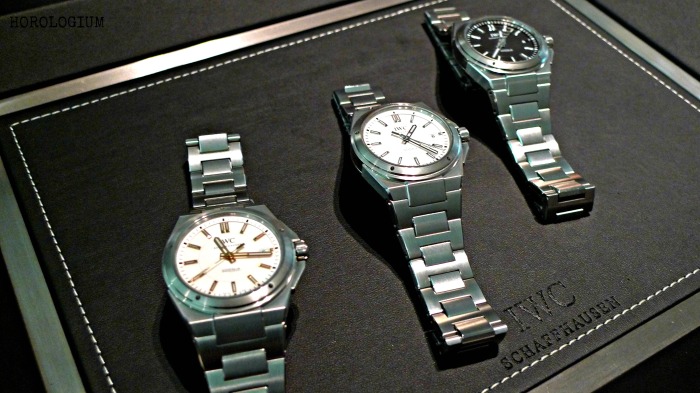That 2013 would be IWC’s year of the Ingenieur, following on from 2012’s year of the Pilot watch, was well-known, so at SIHH the biggest questions were whether the booth would be as eye-catching as 2012’s one (it was), and what the range of models would look like. Well it seems that for this year, IWC have gone all out with the ‘Inge’, as it is affectionately known, from re-designing the base level entry model, up to some rather more complicated affairs.
The more complicated new models are a far cry from the birth of the Ingenieurs in 1955. As befitting the ‘engineer’ name, it was created to be functional watch, its focus on protection against magnetic fields (also the inspiration behind the lightning logo on the dial). The watch had been made with people such as engineers, technicians, doctors and chemists in mind; people who might regularly come into contact with magnetic fields that would affect the operation of their watches. The Inge has been through numerous modernisations in the intervening half century including, most notably, the Gerald Genta designed SL (Steel Line) Collection Inges in 1976, whose design ramped the Inge up to that of a luxury steel watch.
So we come to the 2013 Ingenieuer Automatic. An homage to the Genta design, and also in a 40mm case like Genta’s, this is the only one of the new Ingenieurs with an inner soft iron case to protect it against magnetic fields. Previous Ingenieur models were protected against 80.000 A/m, this one only has a protection for 40.000 A/m.
It is a great clean design; modern but with very clear references to Genta’s design, especially the bezel’s bores, and at 10mm in height, is not too thick. It comes in three stainless steel iterations with black and white dials. The black dial and one of the white dialled versions have rhodium-plated hands and hour markers, and the second white dialled one has rose gold plated hands and markers. They come on bracelets but black rubber straps are also available.

This is a good looking and accessible (US price is $6,500) watch, and it will no doubt do well. There has been some talk about the movement, that trusty workhorse known as the ETA 2892 (they call the modified ETA 2892 the IWC Calibre 30110) and whether IWC’s use of this, as opposed to an in-house calibre, is an issue. For some it is, for others not, since it means that that IWC have managed to keep it at a more accessible price point. In the end, whether this is of importance or not will be very subjective. It’s a great looking and comfortable watch, and I’ll leave debates about the movement to others.

At the other extreme of the new Ingenieur range is the Constant-Force Tourbillon. This 46mm (14mm high) platinum and ceramic cased watch is a far cry from the early utilitarian Ingenieurs, with a US$290,000 price to match. Its hand wound IWC caliber 94800 features a patented constant-force mechanism integrated in a tourbillon. It has a 96 hour power reserve (shown on the bottom right of the dial) when fully wound and also has a moon phase on the top right of the dial. The moon phase has an intriguing count down to the next full moon and a double moon for the North/ South Hemisphere.
In my next IWC post I’ll cover some of the other new Ingenieurs for 2013, including the AMG Black Series Ceramic, the Chronograph Silberpfeil and the Perpetual Calendar Date-Month
Categories: IWC, SIHH 2013, Switzerland, Watch shows, watches

I do like the new Inge… love the clean design and what an amazing anti-reflective treatment of the crystal!!!
Not sure if i’m interested in the Constant-Force Tourbillon… IWC, please remember the “K.I.S.S” principle…
LikeLike
That Constant-Force Tourbillon is one lovely timepiece, and by weighing in at 46mm I bet that it will have a ton of presence on the wrist!:-)
LikeLike